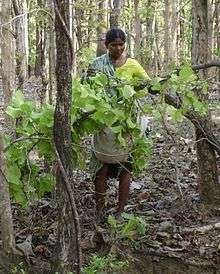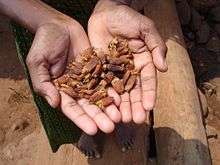Non-timber forest product

Non-timber forest products (NTFPs), also special, non-wood, minor, alternative and secondary forest products, are useful substances, materials and/or commodities obtained from forests which do not require harvesting (logging) trees. They include game animals, fur-bearers, nuts, seeds, berries, mushrooms, oils, foliage, medicinal plants, peat, fuelwood, and forage.[1]
Research on NTFPs have focused on their commodifiability for rural incomes and markets, as an expression of traditional knowledge or as a livelihood option for rural household needs, and, as a key component of sustainable forest management and conservation strategies. All research promote forest products as valuable commodities and tools that can promote the conservation of forests.
Definitions
There is a wide variety of NTFPs, including mushrooms, huckleberries, ferns, transplants, seed cones, piñon seeds, tree nuts, moss, maple syrup, cork, cinnamon, rubber, tree oils and resins, and ginseng. The United Kingdom's Forestry Commission defines NTFPs as "any biological resources found in woodlands except timber,"[2] and Forest Harvest, part of the Reforesting Scotland project, defines them as "materials supplied by woodlands - except the conventional harvest of timber."[3] These definitions include wild and managed game, fish and insects.[4] NTFPs are commonly grouped into categories such as floral greens, decoratives, medicinal plants, foods, flavors and fragrances, fibers, and saps and resins.
Other terms similar to NTFPs include special, non-wood, minor, alternative and secondary forest products. NTFPs in particular highlight forest products which are of value to local people and communities but have been overlooked in the wake of forest management priorities (for example, timber production and animal forage). In recent decades, interest has grown in using NTFPs as alternatives or supplements to forest management practices. In some forest types, under the right political and social conditions, forests can be managed to increase NTFP diversity and, consequently, to increase biodiversity and potentially economic diversity.
Uses
The harvest of NTFPs remains widespread throughout the world. People from a wide range of socio-economic, geographical and cultural contexts harvest NTFPs for a number of purposes, including but not limited to: household subsistence, maintenance of cultural and familial traditions, spiritual fulfillment as well as physical and emotional well-being, scientific learning and income.[4][5] Other terms synonymous with harvesting include wild-crafting, gathering, collecting and foraging. NTFPs also serve as raw materials for industries ranging from large-scale floral greens suppliers and pharmaceutical companies to micro-enterprises centred upon a wide variety of activities (such as basket-making, woodcarving and the harvest and processing of various medicinal plants).
Economic importance
It is difficult to estimate the contribution of NTFPs to national or regional economies as there is a lack of broad-based systems for tracking the combined value of the hundreds of products that make up various NTFP industries. One exception to this is the maple syrup industry, which in 2002 in the US alone yielded 1.4 million US gallons (5,300 m3) worth USD$38.3 million.[6] In temperate forests such as in the US, wild edible mushrooms such as matsutake, medicinal plants such as ginseng, and floral greens such as salal and sword fern are multimillion-dollar industries. While these high-value species may attract the most attention, a diversity of NTFPs can be found in most forests of the world.
In tropical forests, for example, NTFPs can be an important source of income that can supplement farming and/or other activities. A value-analysis of the Amazon rainforest in Peru found that exploitation of NTFPs could yield higher net revenue per hectare than would timber harvest of the same area, while still conserving vital ecological services.[7] Their economic, cultural and ecological value, when considered in aggregate, makes managing NTFPs an important component of sustainable forest management and the conservation of biological and cultural diversity.
Research
Research on NTFPs have focused on three perspectives: NTFPs as a commodity with a focus on rural incomes and markets, as an expression of traditional knowledge or as a livelihood option for rural household needs, and, finally, as a key component of sustainable forest management and conservation strategies. These perspectives promote forest products as valuable commodities and important tools that can promote the conservation of forests. In some contexts, the gathering and use of NTFPs can be a mechanism for poverty alleviation and local development.[8][9]
See also
- Arid Forest Research Institute
- Biomass
- Biomass (ecology)
- Bioproducts
- Ethnobotany
- Indigenous (ecology)
- Wildness
- Wilderness
- Wildlife
References
Notes
- ↑ "Glossary of Forestry Terms in British Columbia" (PDF). Ministry of Forests and Range (Canada). March 2008. Retrieved 2009-04-06.
- ↑ "Forest Research - Social, cultural and economic values of contemporary non-timber forest products: Wild Harvests". Forestry.gov.uk. Retrieved 2013-11-21.
- ↑ "non timber forest products in Scotland". ForestHarvest. Retrieved 2013-11-21.
- 1 2 "Forests and non-timber forest products". Cifor.org. Retrieved 2013-11-21.
- ↑ Kala, CP. (2013). "Harvesting and Supply Chain Analysis of Ethnobotanical Species in the Pachmarhi Biosphere Reserve of India," American Journal of Environmental Protection 1(2), pp.20-27.
- ↑ "SIC 0831 Forest Nurseries and Gathering of Forest Products". Encyclopedia of American Industries, 5th ed. Gale. 2008.
- ↑ Peters, Charles M.; Alwyn H. Gentry; Robert O. Mendelsohn (29 June 1989). "Valuation of an Amazonian rainforest". Nature 339. doi:10.1038/339655a0.
- ↑ Belcher, B.M. (2003). "What isn't an NTFP?". International Forestry Review 5 (2): 161–168. doi:10.1505/IFOR.5.2.161.17408.
- ↑ Kala, CP 2003. Medicinal Plants of Indian Trans-Himalaya. http://www.cabdirect.org/abstracts/20066710101.html;jsessionid=453D5B8DEE32770EACE0E447E613263E
Bibliography
- Delang, Claudio O. 2006. The Role of Wild Food Plants in Poverty Alleviation and Biodiversity Conservation in Tropical Countries. Progress in Development Studies 6(4): 275-286
- Emery, Marla and Rebecca J. McLain; (editors). 2001. Non-Timber Forest Products: Medicinal Herbs, Fungi, Edible Fruits and Nuts, and Other Natural Products from the Forest. Food Products Press: Binghamton, New York.
- Guillen, Abraham; Laird, Sarah A.; Shanley, Patricia; Pierce, Alan R. (editors). 2002. Tapping the Green Market: Certification and Management of Non-Timber Forest Products. Earthscan
- Jones, Eric T. Rebecca J. McLain, and James Weigand. eds. 2002. Non Timber Forest Products in the United States. Lawrence: University Press of Kansas.
- Mohammed, Gina H. 2011. The Canadian NTFP Business Companion: Ideas, Techniques and Resources for Small Businesses in Non-Timber Forest Products & Services. Candlenut Books: Sault Ste Marie, Ontario
External links
- Center of Minor Forest Products
- Center for Livelihoods and Ecology
- FAO Nonwood Forest Products Website
- Non Timber Forest Product United States
- Midwest Special Forest Products
- Nontimber Forest Products in Alaska
- Northern Forest Diversification Centre
- NTFP.org
- Virginia Tech Non-Timber Forest Products
- Alaska mushroom guide : for harvesting morels / compiled and written by Jay Moore. Hosted by the Alaska State Publications Program.
- Nepal NTFP Network (NNN)
- Lao NTFP Wiki
- P&M Technologies - NTFP Page
| |||||||||||||||||||||||||||||||||||||||||||||
| ||||||||||||||||||||||||||||||
| |||||||||||||||||||||||||||||||||||||||||||||||||||||||


